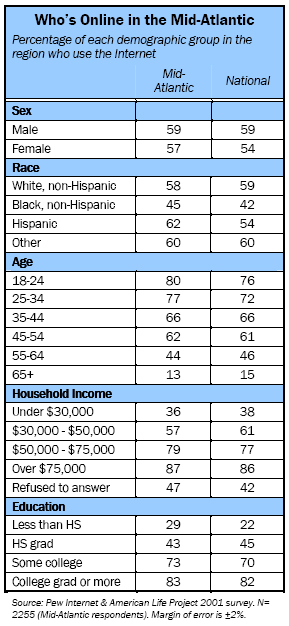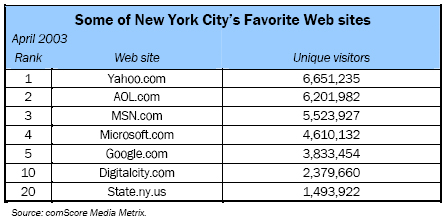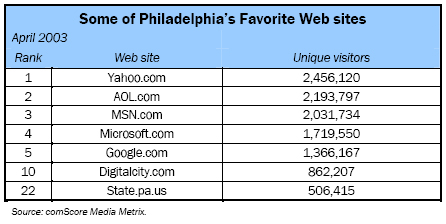The Mid-Atlantic continues to be among the most wired regions and has the highest proportion of female adult Internet users in the country. Growth in Internet usage has leveled off in the Mid-Atlantic.
The Mid-Atlantic is one of the most wired regions in the United States, and Internet users in the four Mid-Atlantic states (Delaware, New Jersey, New York, Pennsylvania) stand out against those in other regions of the country for several reasons:
The user population in the Mid-Atlantic experienced almost no growth in 2002. As in 2001, about 58% of adults in the region in 2002 were Internet users. This still represents substantial growth from 2000, when 51% of adults had used the Internet.
- The region has the highest proportion of female Internet users (54%) of any region in the country.
- A high proportion of the region’s Internet users have college or graduate degrees (38%).
- Users in the Mid-Atlantic particularly enjoy looking for information online about hobbies, and they are more likely to shop online than users in most other regions. The same holds true for surfing the Net for fun.
- But they are less likely than their peers elsewhere to turn to the Internet to answer a question.
Growth in Internet usage has leveled off in the Mid-Atlantic.
In 2002, 58% of adults were Internet users, which is about the same penetration rate as 2001. At the same time, this matches the 2002 national penetration rate of 59%. The region saw substantial growth between 2000 and 2001 – in 2000, 51% of adults there had been online.
The online experience of users in the Mid-Atlantic almost exactly mirrors that of the national user population.
About 44% in the Mid-Atlantic region have been using the Internet for over three years; across the nation, a similar 44% of users have that much online experience. An additional 34% of those going online in the Mid-Atlantic have about two years’ experience, and another 22% have a year or less. By comparison, the exact same proportions of users nationally have the same amount of online experience.
In the region’s overall Internet population, those in higher income households dominate. A quarter of Internet users (26%) live in households with incomes over $75,000; in contrast, 16% of the region’s Internet users live in households earning less than $30,000. Another 22% earn between $50,000 and $75,000 a year, and about 19% of users take home between $30,000 and $50,000 a year.5

About 38% of users in the Mid-Atlantic have a bachelor’s degree or better and 26% have had some college experience; another 30% have a high school diploma, and about 6% have less than a high-school education. In the Mid-Atlantic, about 29% of adults who have not earned high school diplomas have gone online, compared to 22% of such people across the country.
The racial makeup of Internet users in the four Mid-Atlantic states is almost exactly the same as the makeup of the national user population. Just over three-quarters (78%) of users in both the Mid-Atlantic and across the country are white. About 9% of users in the Mid-Atlantic are African-American, with 8% Hispanic, and 5% from other races.
Hispanics in the Mid-Atlantic are much more likely to have used the Internet compared to Hispanics nationally, and Hispanics are also the most connected ethnic group in the region.6 Fully 62% of Hispanics in the Mid-Atlantic use the Internet, compared to 54% of Hispanics nationally. At the same time, the 62% of Hispanics online is larger, in relative terms, than the 58% of whites and 45% of African-Americans using the Internet in the Mid-Atlantic States.
The gender ratio of users in the Mid-Atlantic reflects the recent surge of women online. Across the country, the gender ratio of users is 50-50, but the Mid-Atlantic user population is 54% female. This is the highest proportion of female Internet users of any region in the country; the next highest is the Mountain region, which is 53% female. The gender ratio of users in the Mid-Atlantic contrasts sharply with that of New England, which is 55-45 male-to-female. Meanwhile, 57% of women in the Mid-Atlantic use the Internet, as compared to 54% of women nationwide.
The age breakdown of Internet users in the Mid-Atlantic states almost exactly mirrors that of the national user population. About 16% are young adults between the ages of 18 and 24; almost a quarter (23%) are between 25 and 34; 28% are between the ages of 35 and 44; about 21% are between 45 and 54; and 13% are over the age of 55. The Mid-Atlantic has the highest proportion of those between 35 and 44 of any region in the country – nationally, about 26% of users are in this age bracket. At the same time, the Mid-Atlantic has one of the lowest proportions (4%) of seniors over 65 using the Internet. Both the South and the Capital Region have a similarly small proportion of senior citizens online.
About 65% of users in the Mid-Atlantic states hold full-time jobs; 15% work part-time. Both proportions are virtually the same as the national averages (64% and 14%).
Users in the Mid-Atlantic states enjoy the same online activities as their peers in other regions.
One activity that is especially popular among Mid-Atlantic users is looking for online information about hobbies. About 81% of users in the region have done this, compared with 78% of users across the country.
By contrast, users in the Mid-Atlantic are a bit less likely than many of their peers to turn to the Internet when they need to answer to a question. This activity is one of the Internet’s most popular, with about 75% of all users having said they have done this at one time or another. In the Mid-Atlantic, about 73% of users have done this. Compared to other regions, Mid-Atlantic users are less likely to have done this activity than users in other parts of the country, especially those users in New England, where 89% of them had used the Internet when they had a question.
As for other online activities tracked during 2001, users in the Mid-Atlantic engaged in them at about the same rate as the national averages, with some small variations.
Sending and receiving email is by far the most popular online activity, and about 88% of users across the country have done this at one time or another. This proportion is just about the same as in the Mid-Atlantic (89%). At the same time, 61% of users in the Mid-Atlantic get news online; 37% look for financial information; 58% look for information about health concerns; 39% use the Internet for research purposes at their job; 65% go online “just for fun”; and 48% use the Internet to buy something.
Compared with users in other regions, users in the Mid-Atlantic do favor some online activities over Internet users in other parts of the country. This includes shopping online; only users in New England (55%) and California (53%) are more likely than users in the Mid-Atlantic to have done this. Going online just to pass time is also a popular activity in the Mid-Atlantic, and only users in the South (67%) and in the Midwest (70%) like to surf the Net just for fun more than those in the Mid-Atlantic. Use of the Net for this reason is 16 percentage points higher in the Mid-Atlantic (65%) than in the Pacific Northwest (49%).
Doing job research on the Internet is less common in the Mid-Atlantic than in other parts of the country. With 39% of users who have done so, the Mid-Atlantic is near the bottom in this category, trailed only by the Pacific Northwest (38%). In every other region of the country, more than 40% of the users have made use of the Internet at their jobs.
Mid-Atlantic users are average in their daily use of the Internet. They access the Internet from home through dial-up connections.
More than half (57%) of the Internet users in the Mid-Atlantic use the Internet on a typical day. This puts the Mid-Atlantic region squarely in the middle in terms of average daily use, behind the heavy users in the Pacific Northwest (63%) but ahead of users in the South, where only about 51% are online on a typical day.
They access the Internet from home through dial-up connections.
Like most users across the country, most users in the Mid-Atlantic connect from home to the Internet via a standard dial-up connection. Fully 80% of users in the Mid-Atlantic connect this way; the national average is 82%. About 12% of users in the Mid-Atlantic connect via a high-speed cable modem, second only to the 16% of users in New England who connect to the Internet this way. An additional 4% of users in the Mid-Atlantic have a DSL line.
The home and the workplace are the two most likely places for a person to connect to the Internet. Nationally, 86% of users go online from their home, and 50% of users do so from their job. Users in the Mid-Atlantic are about as likely to have connected from home (87%), while 51% of them have gone online from their workplace. Again, these rates of access put users in the Mid-Atlantic squarely in the middle when compared with users in other parts of the country. For instance, users in California (89%) and the Mountain states (90%) are more likely to go online from home, while users in the Capital Region (56%) are more likely to go online from work.
When users in the Mid-Atlantic go online on an average day, they are as likely to go online from home or from the workplace as the national average. On an average day, about three-quarters of users (74%) who access the Internet in the Mid-Atlantic do so from home, while 42% do so from work. Nationally, 76% of users have gone online from home on a typical day, while 40% have done so from their job. Again, these rates put users in the middle compared with their peers in other parts of the country.
The number of times people go online and the amount of time spent online on an average day in the Mid-Atlantic region are in line with the national averages. About 39% of users in the Mid-Atlantic states go online several times a day, about 2 percentage points higher than the national average but behind the 45% of users in the Capital region who go online that many times a day. About 23% of users in the Mid-Atlantic go online about once a day; about 17% go online at least three to five times a week; 13% access the Internet about once or twice a week; and about 6% use the Internet less than once a week.
When users in the Mid-Atlantic are online on a typical day, about 60% of them spend an hour or less online – 26% will spend less than 30 minutes in cyberspace, and 34% will be online from 30 to 60 minutes. Nationally, about 62% of users spend an hour or less online (36% spend about 30 minutes to an hour, while 26% of users spend less than 30 minutes online). At the same time, about 9% of users in the Mid-Atlantic are online from one to two hours a day, another 12% spend two to three hours in cyberspace, about 6% stay online from three to four fours, and about 12% are heavy users who are online for more than four hours on a typical day. The proportion of heavy users is one of the highest in the country, along with California (13%), the Capital region (13%) and the Border states (13%).
Those in the Mid-Atlantic perceive a somewhat positive impact on their lives from the Internet. In March 2000, users were asked several questions about the extent to which the Internet had helped them improve aspects of their daily life – shopping, getting health information, managing their finances, connecting with family and friends, learning new things, and pursuing a hobby.
For the most part, Internet users in the four states of the Mid-Atlantic region agree with other online Americans that the Internet has had a somewhat positive impact on their lives. About 38% said that their ability to shop had seen some or a lot of improvement, 4 percentage points higher than the national average. This is in line with the finding above that Mid-Atlantic Internet users are among the country’s most prolific Web shoppers. About 17% said they had seen a large improvement, slightly higher than the 15% of users nationally who said the same thing.
Looking for health information online is a popular Web activity as well, but for the most part, users have yet to see the Internet making a marked improvement in their ability to get such information. About 16% of users in the Mid-Atlantic said their ability to find health information had improved a lot, while another 19% had seen some improvement.
Managing one’s finances online does not seem to be of much importance to many users, including those in the Mid-Atlantic region. Only about 41% had seen any improvement at all, from “only a little” to “a lot,” because of the Internet. About 58% had seen no improvement at all. Nationally, about 40% of users saw an improvement of some kind.
The Internet’s ability to improve connections to friends and family is well documented. While users in the Mid-Atlantic agree, their enthusiasm is not as strong as it is nationally. About 49% had seem some or a lot of improvement in their connections to family members because of the Internet, while 58% saw a similar improvement in their connections with their friends. By comparison, about 55% of users nationally saw such improvement with members of their family; 61% saw a similar improvement in their connections to their friends.
The Internet is a treasure trove of information. About 46% of users in the Mid-Atlantic said that the Internet had improved their ability to learn new things a lot; another 31% saw some improvement. These reflect the findings for the national user group.
As stated above, looking for information about hobbies was especially popular among users in the Mid-Atlantic. A little over half (51%) of users there saw some or a lot of improvement in their ability to pursue their hobbies because of the Internet. About 21% said they saw a lot of improvement, about the same as the national average. Meanwhile, 31% of users in the Mid-Atlantic said they saw no improvement at all, the same as users nationally.
There were some changes between 2000 and 2001 in the makeup of the user population and in Internet usage in the Mid-Atlantic.
The strong increase in the percentage of adults who used the Internet between 2000 and 2001 was the most significant – the proportion of adults using the Internet in the Mid-Atlantic jumped from 51% in 2000 to 58% in 2001. Also significant was the surge of women online in the Mid-Atlantic. In 2000, 47% of women in this region were using the Internet. That proportion jumped to 55% of women in 2001, giving the Mid-Atlantic the largest proportion of female users of any region in the country.
Mid-Atlantic users joined the exodus away from looking for financial information online in 2001. They also did a lot less research for their jobs online. By contrast, there was a slight up tick in looking for hobby information on the Web.
Between 2000 and 2001, there was small increase in the percentage of users in the Mid-Atlantic region that went online several times a day. Otherwise, usage patterns in the region stayed the same.
The Mid-Atlantic’s favorite Web sites
The tables below list the top five Web sites in New York City and Philadelphia in April 2003. Those sites are also the top five in the nation and they do not vary much region-by-region. In addition, the table highlights several regional sites that are in the top 25 most heavily used sites in the region during that month. A full listing of the top 25 sites in the region can be found in the spreadsheet that is available here: https://www.pewresearch.org/internet/releases/release.asp?id=66






